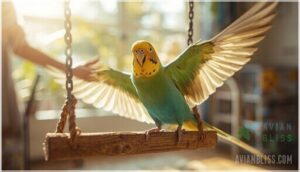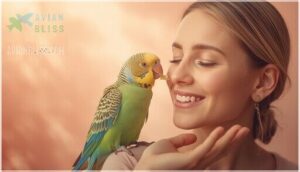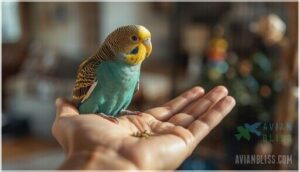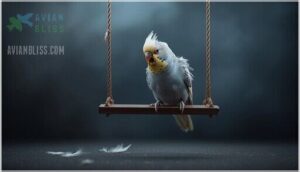This site is supported by our readers. We may earn a commission, at no cost to you, if you purchase through links.
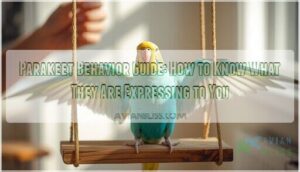
Parakeets don’t hide their feelings behind words. Every wing flap, tail shake, or beak nibble tells a story if you’re willing to listen.
Understanding parakeet behavior isn’t about decoding a secret language; it’s about noticing the small signals that reveal happiness, affection, and even distress. With a keen eye and a little patience, you’ll start to recognize what your bird is expressing and how to respond with confidence.
Table Of Contents
- Key Takeaways
- Signs of Happiness/Contentment
- Signs of Affection/Attachment
- Trying to Communicate With Other Budgies
- Trying to Communicate With Owners
- Signs of Boredom/Obsession
- Signs of Anxiety/Fear
- Signs of Protective/Threatened/Frustrated Behavior
- Signs of Illness/Pain
- Frequently Asked Questions (FAQs)
- How can I understand parakeet behavior?
- How do you know if a parakeet is waking?
- How can you tell if a parakeet is afraid?
- How do you know if a parakeet is aggressive?
- Why do parakeets head Bob?
- How do parakeets communicate?
- Do parakeets talk?
- How do female parakeets behave?
- How do you know what your parakeet is saying?
- How to understand budgie body language?
- Conclusion
Key Takeaways
- Parakeets show happiness and affection through singing, wing flapping, tail shaking, and gentle nibbling.
- Signs of stress or illness include fluffed feathers, hiding, abnormal droppings, and sudden silence.
- Repetitive actions like feather plucking or obsessive attachment to toys signal boredom or anxiety.
- Vocalizations, head bobbing, and beak tapping are key ways parakeets communicate with you and other birds.
Signs of Happiness/Contentment
When your parakeet feels safe and content, you’ll notice a few clear signs. These behaviors often show up in simple, everyday moments.
Here’s what you can look for next time you spend time with your bird.
Singing, Talking, Flapping Wings, Shaking Tail or Tongue
Watch your parakeet and you’ll see how Vocal Learning shapes every moment. When they’re Singing or Talking—whether mimicking your words or chirping their own tunes—they’re using sophisticated parakeet communication methods.
Flapping Wings, sometimes eight to twelve times a day, shows pure excitement or a need to stretch. Tail Signals, quick shakes or side-to-side movements, reveal bursts of joy and contentment. Tongue Control, with rapid wiggling, is a sign they’re truly thrilled. Notice how Beak Expression often pairs with these actions, adding nuance to their mood.
These vocalizations and gestures aren’t random—they’re your bird’s way of sharing happiness, expressing comfort, and inviting you into their lively world. Understanding vocal learning mechanisms can help you better interpret your parakeet’s behavior.
Singing With You, Pecking at Your Ear or Hair, Becoming Attached to Things, Regurgitating Food
If you’ve ever found your parakeet singing with you, you’re witnessing Vocal Bonding in action. This is Social Mirroring at its finest—your bird is echoing your energy and building trust. Pecking at your ear or hair? That’s Attachment Behavior, a gentle sign of affection rooted in flock grooming rituals.
Notice how your bird gets attached to toys or mirrors? Emotional Reinforcement is at play, offering comfort and security. And regurgitating food? It’s a classic Courtship Display, a true gesture of love.
These behaviors show:
- Vocal Bonding
- Affectionate Mimicking
- Attachment to objects
- Regurgitating Food as love.
Understanding parakeet behavior patterns is essential for building a strong bond with your pet.
Signs of Affection/Attachment
If your parakeet sings with you, nibbles your ear, or settles on your shoulder, you’re witnessing real attachment. Regurgitation behavior—your bird offering food—shows deep social bonding and affection. Mutual preening, like gentle grooming of your hair or skin, is a sign of trust and comfort.
You might notice beak tapping, playful “parakeet kisses,” or vocal imitation, all strong attachment signs. These bonding behaviors aren’t random; they’re how your parakeet says, “you belong with me.”
Trying to Communicate With Other Budgies
After witnessing attachment between you and your bird, it’s easy to see how their world expands with others. Flock dynamics run deep—your budgies use bird communication to weave tight social bonds and set the tone for their group. Communication with other budgies isn’t just noise; it’s a tapestry of movement, sound, and ritual. For instance, their contact calls shift and blend, echoing the voices of their closest companions. You’ll notice social behavior and vocal learning play out in real time, shaping the flock’s unique rhythm.
Here are four signs of budgie interactions and communication styles:
- Head bobbing and wing flapping signal excitement and social invitation.
- Beak tapping, their version of a friendly greeting, cements friendships.
- Mutual preening builds trust and strengthens bonds.
- Shared chattering and eating reinforce flock unity and social bonding.
Trying to Communicate With Owners
How do you know your bird is trying to reach you? Vocal learning is front and center—your budgie may mimic your words or string together unique sounds, all aimed at grabbing your attention. That head bob or gentle chirp isn’t random; it’s active attention seeking.
Climbing onto your hand, pinning its eyes, or even nibbling your ear shows trust and social bonding. Parakeet communication with owners is a living dialogue, shaped by daily human interaction and their evolving communication styles.
Signs of Boredom/Obsession
Restlessness is a quiet warning in your bird’s world. Boredom and obsession often show up as stereotypic behaviors—repetitive actions that fill empty hours. You’ll spot these parakeet signs of boredom in daily routines:
- Feather plucking from long stretches of idle time
- Excessive vocalization, loud calls echoing for attention
- Obsessive attachment to one toy or mirror
- Reduced foraging, barely exploring for food
- Repetitive pacing or destructive chewing
Rotating enrichment and stimulation break this cycle, restoring curiosity and calm.
Signs of Anxiety/Fear
Anxiety creeps into your bird’s world like a shadow—changing everything. You’ll spot Stress Signals in trembling bodies, fluffed-up feathers, and sudden silence. Fear Responses erupt as screaming or frantic biting when their nerves snap. Parakeet signs of anxiety and fear often surface after small changes, like a new pet or a loud bang.
Watch for these Behavioral Changes:
- Hiding in corners or freezing on perches
- Over-preening or feather plucking
- Refusing food after stressful events
Environmental Factors matter; your calm helps theirs.
Signs of Protective/Threatened/Frustrated Behavior
Ever seen your parakeet puff up, hiss, and stand tall like a feathered guard? That’s Territorial Defense in action—your bird isn’t backing down. Aggressive Posturing, Resource Guarding, and Frustration Behaviors often surface when their space or food feels threatened. Defensive Vocalizations, like sharp hissing or beak clicking, warn you to keep your distance. These defensive displays in birds aren’t random; they’re signals of protective, threatened, frustrated behavior, shaped by anxiety triggers and the drive to defend what matters most.
- Raised wings and hissing
- Lunging with open beak
- Puffing feathers to look larger
- Biting at cage mates or objects
Signs of Illness/Pain
Imagine your parakeet suddenly perched low, feathers fluffed, silent as a shadow. That’s not just a mood—it’s a warning. Birds hide pain well, but their bodies betray them. Lethargy signs like sleeping midday or sitting motionless speak volumes. If you spot labored breathing or tail bobbing, that’s a red flag for respiratory issues. Dropping changes—watery, discolored, or sticky—hint at illness lurking beneath the surface. Notice feather plucking or poor grooming? Your bird may be fighting discomfort or stress. Appetite shifts, especially ignoring favorite treats, mean something’s off. Parakeet signs of illness and pain are subtle but vital. You know your bird best—trust your instincts. When you see these parakeet health concerns, don’t wait. Early action can make all the difference.
If your parakeet sits low, fluffed, and silent, trust your instincts—these subtle signs of illness mean urgent care is needed
- Fluffed feathers for extended periods
- Labored breathing or tail bobbing
- Abnormal droppings
- Sudden silence or harsh vocalizations
- Loss of appetite or weight
Frequently Asked Questions (FAQs)
How can I understand parakeet behavior?
You might think birds wear their hearts on their feathers. In fact, parakeet socialization shines through swaying tails and cheerful songs—nature’s code for trust.
Watch behavioral cues: head bobbing, chirps, and relaxed postures all reveal emotional intelligence in action.
How do you know if a parakeet is waking?
As your parakeet wakes, watch for subtle morning routine cues: a stretch, feather shake, soft vocalizations, and lively movements.
Daily activity ramps up with gentle chirps, head bobbing, or preening—a clear sign your bird’s sleep cycle is ending.
How can you tell if a parakeet is afraid?
Did you know up to 80% of birds show flight responses to sudden loud noises? Fear signs include trembling, freezing, feather ruffling, or high-pitched screaming.
Watch for stress responses like hiding, silent vocalizations, and anxious body language around anxiety triggers.
How do you know if a parakeet is aggressive?
Raised wings, fluffed feathers, and lunging are classic Aggression Signs. Screaming and biting point to Threat Displays or Fear Responses.
Watch for Territorial Behavior near food or perches—these Aggressive behaviors often reflect shifts in Social Hierarchy or stress.
Why do parakeets head Bob?
Head bobbing is a vivid part of parakeet body language. You’ll see it in courtship displays, territorial behavior, and social bonding.
Their communication styles weave together vocalization and movement, making head bobbing patterns a clear signal of emotion and intent.
How do parakeets communicate?
Your bird weaves a tapestry of vocalizations and social signals—chirping, singing, and mimicking speech. Through beak language, feather communication, and neural expression, these parakeet communication styles reveal moods, invite bonding, and deepen your bird communication connection.
Do parakeets talk?
Picture your budgie perched nearby, eyes bright, mimicking your words with surprising clarity. Parakeets have impressive talking abilities—thanks to specialized brain structure and vocal learning.
With patience, daily interaction, and repetition, their communication styles can include speech imitation and singing.
How do female parakeets behave?
Female parakeet behavior stands out for its boldness and selectivity. You’ll notice territorial gestures, head-bobbing, and regurgitating food as signs of affection.
They often lead flock dynamics, show female dominance, and use vocal imitation in courtship behaviors.
How do you know what your parakeet is saying?
Don’t let their small size fool you—parakeets speak volumes. Vocalization Patterns and Body Language reveal their emotional intelligence and Social Interaction needs.
Watch for Parakeet Whistling, gentle chirps, and relaxed body language. Screaming or sudden movements mean stress.
How to understand budgie body language?
Watch your budgie’s body language closely. Wing flapping and tail wagging show joy, while beak grinding signals contentment.
Relaxed posture and soft feather conditions mean calmness.
Eye contact, head bobbing, and posture analysis reveal their mood instantly.
Conclusion
Like reading footprints in fresh snow, tuning into your parakeet’s signals lets you trace their moods and needs with every glance. This parakeet behavior guide—how to know what they’re expressing—becomes your map, showing you when joy, worry, or affection fills the room.
Each chirp and flutter is a clue. When you notice these signs, you’re not just observing a bird; you’re building trust, safety, and understanding, one small gesture at a time.
- https://vcahospitals.com/know-your-pet/budgies---general
- https://www.news-medical.net/news/20250319/Parakeet-brain-reveals-secrets-of-human-like-speech-patterns.aspx
- https://pmc.ncbi.nlm.nih.gov/articles/PMC9258629/
- https://as.cornell.edu/news/klarman-fellow-studies-vocal-learning-parrots
- https://www.snexplores.org/article/parakeets-talk-brain-areas-humans

